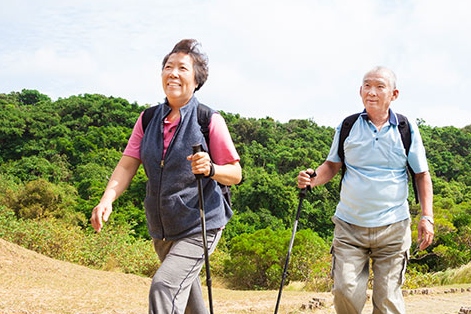Written by Medibank
July 2023

Joint health can have a big impact on overall health and wellbeing, so doing what you can to protect and preserve how healthy your joints are is a smart move.
And luckily, while some things that influence joint health are beyond anyone’s control, there are many other things that you can do and change right now, that will help make a difference to what your joint health looks like in the future. Here, we share 10 tips to help you strengthen your joints.
Eat foods that may assist with inflammation
It’s now recognised that something called chronic inflammation can play an important role in joint health. This may help explain why research not only suggests there’s a link between eating an anti-inflammatory diet and improved quality of life for people living with osteoarthritis, but that targeting how inflammatory the diet is may even play a role in reducing the risk of knee osteoarthritis.
Regarded as one of the world’s healthiest eating patterns, an anti-inflammatory diet is rich in vegetables, fruit, wholegrains, legumes, nuts and extra virgin olive oil. Fish, poultry and eggs are eaten in moderation and red meat is eaten no more than twice a week. Importantly, the health benefits of the Mediterranean diet also rely on what isn’t eaten, too, and highly processed foods, refined grains and foods high in added sugars are rarely on the menu. Also remember that before you begin following a new diet, it’s important to speak to a health professional for advice.
Maintain a healthy weight
Carrying excess weight not only creates extra load for the body’s weight-bearing joints, fatty tissue can also cause inflammatory changes to joints. This goes some way towards explaining why, while being overweight is the biggest risk factor for knee osteoarthritis, it’s also recognised as a risk factor for developing osteoarthritis in the hands, too, even though they don’t carry the body’s load in the same way as the hip and knee joints.
Combined, it means maintaining a healthy weight is one of the key strategies that could prevent up to 70 per cent of osteoarthritis, the most common form of arthritis in Australia.
Exercise regularly
With age, joints can naturally become stiffer and less flexible, mainly because the fluid that lubricates them decreases and the cartilage that lines the joints, acting like a cushion, becomes thinner. However, not only are many of these age-related changes caused by a lack of movement, regular exercise can help to protect against or even reverse the effect.
Australia’s physical activity guidelines recommend doing at least two-and-a-half hours of moderate intensity physical activity each week, ideally trying to do something active most days. If you need some inspiration, get moving with Live Better at Home or find your nearest parkrun.
There are also specific exercises you can try if you’re already starting to experience some hip pain or knee pain.
You should see your doctor before you start any new physical activity program, especially if you haven’t exercised for a long time, are elderly or have a chronic disease (such as arthritis).
Work on your flexibility
In addition to the age-related changes that can occur within the joints, over time the body’s ligaments can shorten and lose their flexibility, which can also make joints feel stiff. As a result, activities that put your joints through their whole range of movement, like stretching, can help to improve the flexibility of your joints and the nearby muscles.
Build your muscle mass
Muscles help to stabilise joints. For example, the quadriceps muscle at the front of the thigh acts as a natural brace for the knee, impacting knee joint stability and loading on that joint. As a result, strength-building exercises are even recommended for joint health to people already living with arthritis.
Guidelines recommend doing muscle-strengthening activities at least 2 days a week.
Avoid getting an injury
That’s not always possible, but for the sake of your joints it’s wise to avoid taking unnecessary risks that may increase your chances of experiencing a joint-related injury, including the sports-related injuries that land more than 66,000 people in Australian hospitals each year.1 Due to the joint damage an injury can cause, joint-related injuries are one of the main risk factors for the development of osteoarthritis.
Improve your posture
On its own, your posture – or in other words, how you sit and stand – can contribute to joint degeneration.
There are a few different things you can do to improve or tweak your posture – and the good news is, some of the same exercises that help to improve joint health are beneficial for posture, too.
Other suggestions to improve and maintain good posture include:
- consciously standing tall, by straightening your spine, letting your shoulders fall to their natural resting position and tightening your stomach muscles slightly
- avoiding soft, unsupportive chairs
- making sure your mattress and your pillow provide enough support
- stretching your neck muscles regularly
- lying on your back, flat on the floor for a couple of minutes each day, if you’re able. This gives your body the opportunity to reset itself to its natural position, which can help to rebalance your posture. Take care when getting up off the floor.
Quit smoking
This is good advice for all kinds of health reasons, but it turns out cigarette smoking may be linked to joint health, too. While some preliminary research suggests there could be a relationship between smoking and osteoarthritis, other research shows smokers have a higher risk of developing rheumatoid arthritis.
If you smoke and want to quit but aren’t sure where to start or just feel like you could use some support, contact Quitline on 137 848 for help.
Limit how much alcohol you drink
Research suggests there’s a link between alcohol consumption and joint health, with one study showing that moderate drinkers had worse knee cartilage than people who drank very little.
According to the National Health and Medical Research Council alcohol guidelines, while there’s no safe level of drinking, having no more than 10 standard drinks a week and no more than four standard drinks in any one day, is wise.
Don’t drink too much coffee
Also consider minimising other caffeine-containing drinks, such as coffee. Research also suggests there’s a link between caffeine and cartilage quality, so that increased caffeine consumption may be another factor that increases the risk of osteoarthritis.
Research around how much caffeine is healthy to drink on a daily basis isn’t clear, but it’s been suggested that adults should stick to around 400mg of caffeine, which equates to about two espresso coffees a day.


Better Knee, Better Me
This program typically combines personalised plans for exercise, weight loss and pain management that aims to help eligible members better manage painful knee osteoarthritis and help reduce the impact it has on their quality of life. Clinical and product eligibility criteria apply. Your program journey may be different depending on your needs.
Read more about taking care of your joints
Looking for something else?
Visit Joint health for more information.
Things you need to know
1 AIHW; Sports injury in Australia; retrieved June 2023
While we hope you find this information helpful, please note that it is general in nature. It is not health advice, and is not tailored to meet your individual health needs. You should always consult a trusted health professional before making decisions about your health care. While we have prepared the information carefully, we can’t guarantee that it is accurate, complete or up-to-date. And while we may mention goods or services provided by others, we aren’t specifically endorsing them and can’t accept responsibility for them. For these reasons we are unable to accept responsibility for any loss that may be sustained from acting on this information (subject to applicable consumer guarantees).




